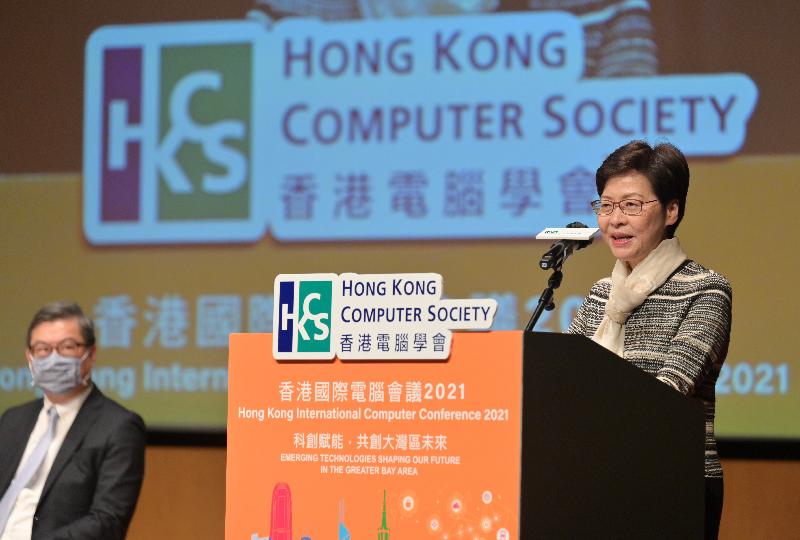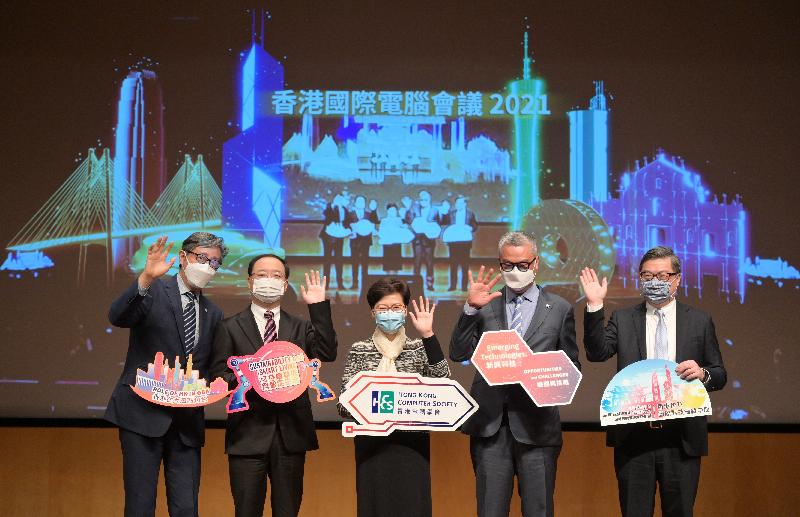Following is the speech by the Chief Executive, Mrs Carrie Lam, at the Hong Kong International Computer Conference 2021 Opening Ceremony today (November 17):
張志�部長 (Director General of the Youth Department of the Liaison Office of the Central People's Government in the Hong Kong Special Administrative Region (HKSAR), Mr Zhang Zhihua), Rocky (President of the Hong Kong Computer Society, Dr Rocky Cheng), Peter (Chairperson of the Organising Committee of the Hong Kong International Computer Conference 2021, Mr Peter Yan), Professor Tam (Chairperson of the Programme Committee of the Hong Kong International Computer Conference 2021, Professor Tam Kar-yan), ladies and gentlemen,
Good morning. I'm delighted to have this welcome opportunity to address you at the 44th edition of the Hong Kong Computer Society's Hong Kong International Computer Conference.
The Society's first conference dates all the way back to 1978. All these years, the Society has tirelessly hosted conferences to facilitate exchanges amongst industry professionals, researchers, government officials and educational practitioners from Hong Kong and from around the world in order to stay abreast of the endlessly accelerating speed and ubiquity of the ICT (information and communications technology) world, as well as to share invaluable insights and intelligence on ICT development and issues related to its application to benefit society. In this year's two-day conference, the Society has clearly captured the latest opportunities for ICT development by adopting the theme "Emerging Technologies Shaping Our Future in the Greater Bay Area".
For our overseas audience, Greater Bay Area stands for the Guangdong-Hong Kong-Macao Greater Bay Area, an economic region with a combined GDP of US$1.7 trillion, a total population of 86 million, and a per capita GDP of over US$19,000, whose further economic drive depends on innovation and technology (I&T). Indeed, comprising nine Mainland cities and the two Special Administrative Regions of Hong Kong and Macao operating under the policy of "One Country, Two Systems", and featuring different legal systems and complementary strengths, the Greater Bay Area itself is a highly innovative framework, within which technology and digitalisation will play a major role in bridging gaps and removing barriers.
Before the Outline Development Plan for the Guangdong-Hong Kong-Macao Greater Bay Area was promulgated in February 2019, the HKSAR Government had already placed innovation and technology high on our policy priorities. Over the past four years, we have invested more than HK$130 billion in I&T development, and the results are encouraging. Our start-ups today number about 3 800. That's 68 per cent more than just four years ago. During the same period, the number of employees in our start-ups has more than doubled to about 14 000. Investors have responded no less enthusiastically to our growing start-up community. Venture capital investment last year increased to HK$10 billion, up 8 per cent as compared to 2017. In addition, according to relevant market research, the gross floor area of data centres in Hong Kong has increased from about 465 000 square metres in 2015 to about 743 000 square metres in 2019, representing an average annual growth rate of around 10 per cent. And I must add, all these achievements took place during an unprecedented period of over two and a half years with the social riots that we have seen in the latter part of 2019 and almost two years of the COVID-19 pandemic.
The Greater Bay Area's relentless rise will only boost those numbers. Under the Outline Development Plan for the Greater Bay Area, the Area will be developed into an international innovation and technology hub, and Hong Kong will play a major part in it. Furthermore, the National 14th Five-Year Plan promulgated in March this year offers clear and compelling support for Hong Kong's development in eight areas, with I&T included in the national plan for the first time.
It is crucial for us to make the most out of the opportunities ahead of us. In my Policy Address delivered last month, I announced a number of groundbreaking measures to fast-track Hong Kong's I&T development. A particularly far-reaching proposal is to build the Northern Metropolis, which takes up 300 square kilometres of Hong Kong land and it is along the Hong Kong-Shenzhen boundary. Within the Metropolis, the Hong Kong-Shenzhen Innovation and Technology Park in the Lok Ma Chau Loop and the surrounding areas will be integrated to form the San Tin Technopole. That will give us about 240 hectares to work with, not only for R&D, but also for advanced manufacturing activities. To give you a feel, the 240 hectares of land for this purpose is almost equivalent to the total area of the three industrial parks now in Hong Kong. Along with the Shenzhen Innovation and Technology Zone across the river, it will come together as the Shenzhen-Hong Kong I&T Co-operation Zone – the central engine for the high-powered development of an international innovation and technology hub in the Greater Bay Area. In addition, we will set aside about five hectares of land in a place called Lau Fau Shan for landmark I&T facilities on a scale comparable to that of Cyberport. In total, we expect that the Northern Metropolis will provide 650 000 jobs, including 150 000 in the I&T sector.
We will also continue to expand the Hong Kong Science Park. For this purpose, we will take forward the Ma Liu Shui reclamation project and vacate the site of the Sha Tin Sewage Treatment Works, providing another 88 hectares of dedicated land for I&T purposes. The Cyberport 5 project has also commenced, which will increase the gross floor area of Cyberport by more than 40 per cent within four years' time.
Since the release of my 2021 Policy Address, I have received very positive feedback on the proposals but almost all industry professionals point to the desperate need for talents, particularly the nurturing of local talents. In the past few years, the Government has implemented various measures to support STEM (science, technology, engineering and mathematics) education in schools, including updating the curriculum, strengthening training for teachers, providing financial and other support, and organising large-scale learning activities. Hopefully that will help produce a steady supply of talents for I&T development in Hong Kong. But school education should be complemented by exposure and activities outside the school, and I look to the Hong Kong Computer Society to support our endeavours in nurturing young talents and start-ups on all fronts.
Finally, my thanks to the Hong Kong Computer Society and its more than 9 000 members for the excellent efforts in promoting I&T and ICT development and application in Hong Kong. I wish you a rewarding conference and the best of health and business in the coming year. Thank you very much.
Follow this news feed: East Asia







